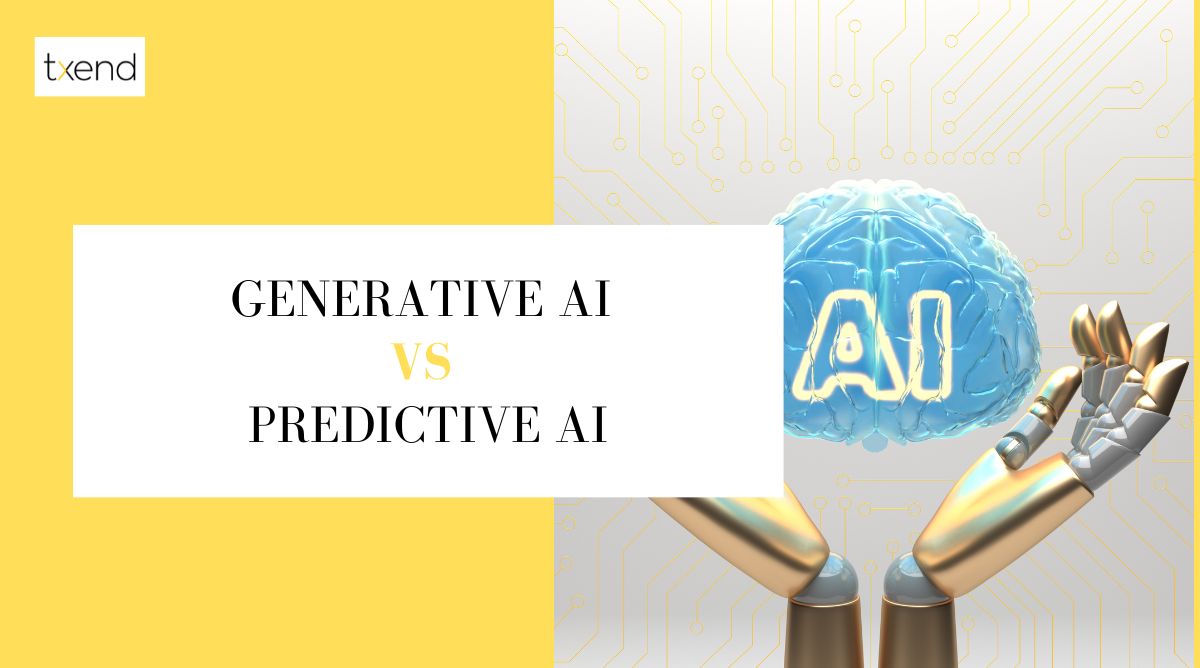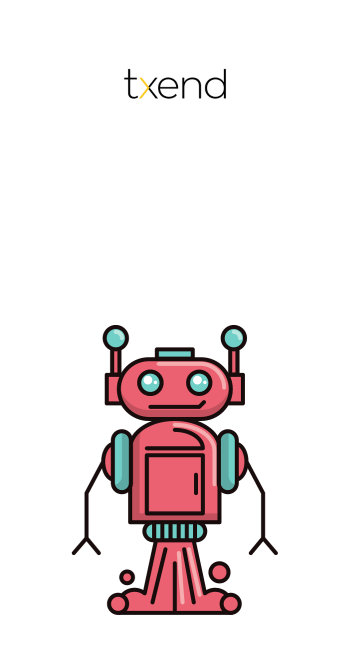
Two of the most fascinating and rapidly evolving areas of artificial intelligence are generative and predictive.
Both technologies can potentially revolutionize many industries and sectors, but they have different strengths and weaknesses.
Generative AI is focused on making fresh content, such as text, images, music, and videos. It can be used to generate new ideas, products, and services. Predictive AI is focused on analyzing historical data to make predictions. It helps spot patterns, trends, and dangers.
This article will compare and contrast generative AI and predictive AI, highlighting their key differences, challenges, and opportunities. We’ll also look at how these technologies can impact the future and solve pressing societal issues.
Key Takeaways
- One subset of artificial intelligence (AI) called “generative AI” is capable of creating original text, graphics, music, and video material.
- Predictive AI is a type of artificial intelligence that uses historical data to make predictions about the future.
- Predictive AI systems start by collecting and processing a significant amount of historical and real-time data.
- Text corpora, picture databases, and music libraries are just a few of the resources that can be used to train generative AI models.
Generative AI Vs Predictive AI
Generative AI is focused on making new content, such as text, images, music, and videos. It can be used to generate new ideas, products, and services. Predictive AI is focused on analyzing historical data to make predictions. It is useful for spotting patterns, trends, and dangers.

4 Categories of Artificial Intelligence
Strong AI:
Artificial general intelligence (AGI), or strong AI, is a theoretical kind of AI that is equivalent to human intelligence. It would be able to learn and adapt to new situations, and it would be able to solve problems creatively and innovatively. Generative AI and predictive AI are both types of weak AI.
Weak AI:
Weak AI, also known as narrow AI, is a type of AI that is designed to perform a specific task. For example, a weak AI might be able to play chess or translate languages. Generative AI and predictive AI are both types of weak AI.
Super AI:
Super AI is a hypothetical type of AI that would be more intelligent than a human being. It could outperform humans in all cognitive tasks, including creativity, problem-solving, and social intelligence. Generative AI and predictive AI are not super AI.
How Does Generative AI Work?
One subset of artificial intelligence (AI) called “generative AI” is capable of creating original text, graphics, music, and video material. It is trained on vast volumes of data in order to identify patterns and relationships, and it then applies this understanding to produce new material that has resemblance to the training data.
Generative AI is still in the early stages of development, but it can potentially revolutionize many industries and sectors.
For example, generative AI can be used to create personalized educational content, new forms of art and entertainment, and new medical treatments.
Here are some examples of generative AI in use in the US:
Google Is Using Generative AI To Improve Its Search Engine.
For example:
Google uses generative AI to create text snippets that appear in search results. These snippets are designed to be informative and helpful, and they can help users to quickly find the information they are looking for.
Amazon Is Using Generative AI To Improve Its Product Recommendations.
For example:
Based on consumers’ past browsing and purchase behavior, Amazon employs generative AI to offer products to them. This helps customers discover new products they are likely to be interested in.
Microsoft Is Using Generative AI To Improve Its Office 365 Suite Of Productivity Tools.
For example:
Microsoft is using generative AI to develop new features for Word, Excel, and PowerPoint that can help users create more engaging and informative presentations.
Netflix Is Using Generative AI To Improve Its Content Recommendations.
For example,
Netflix makes movie and TV program recommendations to viewers based on their viewing interests and history using generative AI. This makes it easier for users to discover fresh stuff they would probably appreciate.
What Is Predictive AI?
Predictive AI is a type of artificial intelligence that uses historical data to make predictions about the future. It can be used to identify trends, patterns, and risks, and to make better decisions about how to allocate resources and optimize operations.
Predictive AI is used in a wide range of industries and applications in the US, including:
Retail:
Predictive AI is used by retailers to forecast demand, optimize inventory levels, and personalize marketing campaigns.
Finance:
Predictive AI is used by banks and other financial institutions to detect fraud, assess risk, and make investment decisions.
Healthcare:

Predictive AI is used by healthcare providers to diagnose diseases, predict patient outcomes, and develop personalized treatment plans.
Manufacturing:
Predictive AI is used by manufacturers to improve quality control, predict machine failure, and optimize production schedules.
Government:
Predictive AI is used by the US government to improve public safety, detect crime, and forecast natural disasters.
Critical Differences Between Generative AI And Predictive AI
| Generative AI | Predictive AI | |
|---|---|---|
| Focus: | Creating new content | Forecasting the future |
| Applications: | Art, music, literature, design, and more | Retail, finance, healthcare, manufacturing, and more |
| Algorithms: | Variational autoencoders, generative adversarial networks, diffusion models | Regression analysis, machine learning algorithms, statistical models |
| Creativity/Inferring the future: | High | High |
How Does Predictive AI Work?
Data Collection:
Predictive AI systems start by collecting and processing a significant amount of historical and real-time data. This data can come from various sources, such as sensors, databases, websites, or any other relevant data repositories.
Data Preprocessing:
Before creating forecasts, the gathered data must be cleaned and prepared. This involves handling missing values, normalizing data, and addressing outliers to ensure the data is suitable for analysis.
Feature Selection:
Relevant features or attributes within the data are chosen to build predictive models. Feature selection is critical to improving the accuracy of predictions.
Algorithm Selection:
Predictive models are constructed using a variety of machine-learning algorithms. Common algorithms include linear regression, decision trees, support vector machines, and neural networks, among others.
Training The Model:
The chosen algorithm is trained on a portion of the historical data. During training, the model learns the relationships between the selected features and the outcomes it aims to predict.
Validation And Testing:
To evaluate the model’s accuracy and capacity for generalization, it is tested and verified on a different dataset after training. To ensure resilience, cross-validation techniques might be used.
Prediction:
After successful training and validation, the model is ready to make predictions. It takes in new, unseen data and produces predictions or forecasts based on the patterns it has learned from the training data.
Continuous Learning:
Predictive AI models are often fine-tuned and updated regularly to adapt to changing data and improve their accuracy over time.
In summary, “How does Predictive AI work?” is a question that prompts an explanation of how artificial intelligence systems use data, algorithms, and training to make predictions about future events or trends.
It’s a fundamental concept within the broader field of AI and machine learning, and understanding how it works is crucial for utilizing Predictive AI in various applications, such as business forecasting, recommendation systems, and predictive maintenance, among others.
How Does Generative AI Work?
Text corpora, picture databases, and music libraries are just a few of the resources that can be used to train generative AI models. Generative AI models can be trained on a variety of datasets, such as text corpora, image databases, and music libraries.
After being trained, a generative AI model can be instructed to produce new content.For example, a text-to-image generative AI model could be prompted with the words “a cat sitting on a red couch” and would then generate an image of a cat sitting on a red couch.
Generative AI is a rapidly developing field, and new algorithms are being developed all the time. As generative AI models become more sophisticated, they will be able to generate new content that is even more realistic and creative.
Here are some examples of how generative AI is being used today:
- Google is using generative AI to improve its search engine and develop new products such as Bard.
- Amazon is using generative AI to improve its product recommendations and customer service.
- Microsoft is using generative AI to improve its Office 365 suite of productivity tools.
- Generative AI is also being used to create new forms of art and entertainment, personalize content for users, and generate realistic special effects.
Generative AI is a powerful technology with the potential to revolutionize many industries and sectors.
However, like any technology, it has both pros and cons.
Pros
- Creativity: Innovative and novel goods, services, and content can be produced with the help of generative AI.For example, generative AI can be used to create new designs for products, generate new music and art, and create personalized content for users.
- Efficiency: Generative AI can automate tasks that are currently performed by humans. This can save businesses time and money. For example, generative AI can be used to automate the generation of product descriptions, the creation of customer-facing content, and the development of new software applications.
- Personalization: Users can have individualized experiences thanks to generative AI. For example, generative AI can be used to recommend products to users, personalize the content that users see, and create targeted marketing campaigns.
Cons
- Bias: Generative AI models are trained on data, and if that data is biased, the model will also be biased. This may cause offensive or discriminating content to be produced.
- Misinformation: False information such as deepfakes and fake news can be produced using generative AI.This can damage reputations and sow discord in society.
- Job displacement: As generative AI becomes more sophisticated, it is possible that some jobs will be displaced by automation. Social instability and higher unemployment could result from this.
Pros And Cons Of Predictive AI
Predictive AI is a powerful technology with the potential to revolutionize many industries and sectors.
However, like any technology, it has both pros and cons.
Pros
- Better decision-making: Predictive AI can help businesses and individuals make better decisions by providing insights into the future. For example, predictive AI can be used to forecast demand, identify trends, and assess risk.
- Improved efficiency: Predictive AI can automate tasks and processes, which can save businesses time and money. For example, predictive AI can be used to automate fraud detection, customer segmentation, and predictive maintenance.
- Personalized experiences: Predictive AI can be used to create personalized experiences for users. For example, predictive AI can be used to recommend products to users, personalize the content that users see, and target marketing campaigns.
Cons
- Bias: Predictive AI models are trained on data, and if that data is biased, the model will also be biased. This can lead to inaccurate predictions and unfair outcomes.
- Privacy concerns: Predictive AI models can collect and analyze large amounts of data about individuals. This brings up data security and privacy.
- Job displacement: As predictive AI becomes more sophisticated, it is possible that some jobs will be displaced by automation. Social instability and higher unemployment could result from this.
Generative AI has a wide range of use cases in a variety of industries and sectors.
Here are a few examples:
Art And Entertainment:
Generative AI can be used to create new forms of art and entertainment, such as music, painting, and video.
For example, With the application of generative AI, it is possible to create original music, realistic photos and films, and user-specific content.
Product Design And Development:
It is possible to create new goods and manufacturing techniques with the help of generative AI.
For example, Regenerative AI can be used to streamline production processes, create new materials, and design new medical equipment.
Healthcare:
Generative AI can be used to identify illnesses, design individualized treatment regimens, and generate novel medications and therapies.
For example, generative AI can be used to develop new drug candidates, predict patient outcomes, and generate realistic medical images.
Generative AI Use Cases

Marketing And Sales:
Personalized marketing campaigns, lead generation, and better customer service may all be accomplished with the help of generative AI.
For example, generative AI can be used to recommend products to users, create targeted marketing messages, and generate personalized responses to customer inquiries.
Education And Training:
Personalized learning experiences, interactive simulations, and educational content can all be produced with the help of generative AI.
For example, Generative AI can be used to provide customized lesson plans for students, realistic training simulations for professionals, and learner-specific feedback.
Predictive AI Use Cases
There are numerous applications for predictive AI across numerous domains and industries.
Here are a few examples:
Business:
Predictive AI can be used to forecast demand, identify trends, and assess risk. This information can then be used to make better decisions about pricing, inventory, marketing, and other business operations.
For example, Walmart uses predictive AI to forecast demand for its products and optimize its inventory levels.
Finance:
Predictive AI can be used to detect fraud, assess credit risk, and make investment decisions.
For example, banks use predictive AI to detect fraudulent transactions and to assess the creditworthiness of loan applicants.
Healthcare:
Predictive AI can be used to diagnose diseases, predict patient outcomes, and develop personalized treatment plans.
For example, Predictive AI is used by hospitals to create individualized treatment regimens for cancer patients and to identify people who may experience difficulties.
Manufacturing:
Predictive AI can be used to predict machine failure, optimize production lines, and improve quality control.
For example, factories use predictive AI to predict when machines are likely to fail and to schedule maintenance accordingly.
Retail:
Predictive AI can be used to forecast demand, personalize marketing campaigns, and recommend products to customers.
For example, Amazon uses predictive AI to recommend products to its customers and to personalize its marketing campaigns.
Future of AI
The future of AI is very bright. AI is already having a major impact on many industries and sectors, and this impact is only going to grow in the coming years.
The way we produce content—from software and art to music and literature—could be completely transformed by generative artificial intelligence. Predictive AI has the potential to help us make better decisions about everything from our finances to our health.
Here are some specific ways in which generative AI and predictive AI are expected to impact the future:
Generative AI:
Generative AI is expected to be used to create new forms of art and entertainment, develop new products and services, and personalize experiences for users.
For example, generative AI could be used to create new musical genres, develop new fashion trends, and generate personalized educational content.

Predictive AI:
It is anticipated that predictive AI would be utilized to enhance decision-making across a broad spectrum of sectors, including manufacturing, retail, healthcare, finance, and business.
For example, predictive AI could be used to forecast demand, identify trends, and assess risk.
What Can Txend Do?
Txend is a software development company that offers a wide range of services, including:
- Web development
- Mobile development
- Data science
- Cloud computing
- Digital marketing
- Graphic design
Txend is a leading provider of software development services, and it is well-positioned to help businesses leverage generative AI and predictive AI to improve their operations and achieve their goals.
In addition to the above, Txend can also use generative AI and predictive AI to develop new software applications and services.
For example, Txend could develop a new software application that uses generative AI to create personalized educational content for students. Or, Txend could develop a new service that uses predictive AI to help businesses forecast demand and optimize their inventory levels.
Txend is a creative and innovative company, and it is always looking for new ways to use technology to help its clients. If you have a business challenge that you think generative AI or predictive AI could help you solve, Txend is a company that can help.
Frequently Asked Questions
Generative AI is good for creating new and original content, such as text, images, and music. It can also be used to personalize experiences for users and to automate tasks.
Google is not a generative AI in itself, but it uses generative AI in many of its products and services, such as Google Search, Google Translate, and Bard.
Yes, chatbots can be generative AI. Chatbots that can produce discussions with users that sound natural can be made using generative AI.
A subset of machine learning known as “predictive AI” looks for patterns and trends in past data to forecast future events.
A kind of machine learning called generative AI has the ability to produce unique content like writing, graphics, and music. Any algorithms that have the ability to learn from data and gradually enhance their performance are included in the larger field of machine learning.
Conclusion:
The debate between Generative AI and Predictive AI is at the forefront of innovation and research in the quickly changing field of artificial intelligence. Both methodologies are integral to the AI ecosystem, offering distinct advantages and posing unique challenges.
This article has explored the key differences, applications, and the potential future landscape of Generative AI versus Predictive AI. As we conclude, let us recap the primary keyword, “Generative AI vs Predictive AI,” to emphasize the core theme of this discussion.
Generative AI is a groundbreaking field that focuses on the creation of content, be it text, images, or even music, that is generated by the AI model itself. This technology holds immense potential in creative endeavors, such as content generation, art, and even drug discovery.
The ability of Generative AI to imagine new possibilities is a testament to its power, and it has been increasingly used in various industries to streamline content creation and foster innovation.
On the other hand, Predictive AI primarily deals with making informed predictions based on historical data and patterns. It excels in areas like recommendation systems, predictive maintenance, and financial forecasting.
Predictive AI has proven to be a valuable asset for businesses aiming to optimize their operations, enhance user experiences, and make data-driven decisions.
The comparison of these two AI approaches reveals a series of challenges and opportunities:
1. Data Requirements:
Generative AI often requires large volumes of data to produce high-quality content, while Predictive AI can be more effective with smaller datasets. Balancing data availability with AI goals is crucial.
2. Ethical Concerns:
The generation of deepfake content and the potential misuse of Generative AI for unethical purposes highlight the ethical concerns associated with this technology. Careful oversight and regulations are essential to mitigate these risks.
3. Hybrid Solutions:
Combining Generative and Predictive AI can result in more powerful AI systems. Hybrid models can harness the creativity of Generative AI and the precision of Predictive AI to deliver robust solutions.
4. Evolving Landscapes:
Both Generative and Predictive AI are continually evolving. Staying updated with the latest developments in each field is crucial for organizations and professionals to harness their full potential.
In conclusion, “Generative AI vs Predictive AI” represents a dynamic interplay of capabilities within the AI domain. While they serve distinct purposes and have unique challenges, they are not mutually exclusive. The particular requirements of the task at hand frequently determine which of them to use. The future of AI lies in understanding how to leverage the strengths of each approach best and navigate their associated challenges.
